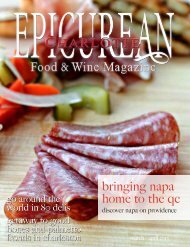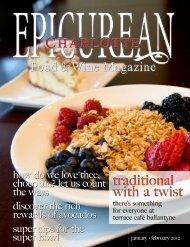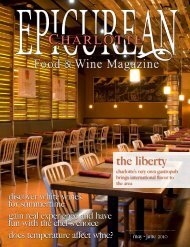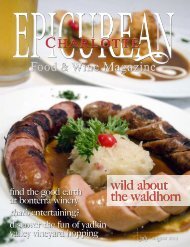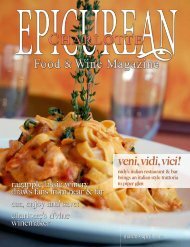señor tequila cantina - Epicurean Charlotte Food & Wine Magazine
señor tequila cantina - Epicurean Charlotte Food & Wine Magazine
señor tequila cantina - Epicurean Charlotte Food & Wine Magazine
Create successful ePaper yourself
Turn your PDF publications into a flip-book with our unique Google optimized e-Paper software.
juicy<br />
morsels<br />
a sight to see and eat:<br />
edible flower gardening<br />
by dr. leonard perry<br />
tired of the same old green beans, carrots and<br />
zinnias in your garden? This year, when ordering<br />
your seeds from the catalogs, check out the edible<br />
flower varieties.<br />
That’s right, edible flowers. The concept is not<br />
new; flower cookery has been traced back to Roman<br />
times and was especially popular in the Victorian era.<br />
Today, many restaurant chefs and innovative home<br />
cooks garnish their entrees with flower blossoms<br />
for a touch of elegance.<br />
But one very important thing that you need to<br />
remember is that not every flower is edible. In fact,<br />
sampling some flowers can make you very, very<br />
sick. You also should never use pesticides or other<br />
chemicals on any part of any plant that produces<br />
blossoms you plan to eat.<br />
So, that’s the first thing to look for when purchasing<br />
flower seeds. Make sure the listing in the seed<br />
catalog identifies the variety as an edible flower.<br />
One edible flower variety that everyone is<br />
familiar with is the sunflower. Choose a mammoth<br />
or giant variety. You can harvest the seeds after<br />
the petals drop, cure them, then eat them raw or<br />
oven-roasted.<br />
Here are some other possibilities for edible<br />
flowers:<br />
Johnny Jump-ups (viola tricolor)<br />
This tender perennial has tiny, pansy-like flowers<br />
in deep purple, mauve, yellow and white. Blossoms<br />
have a mild wintergreen flavor and can be used in<br />
salads, to decorate cakes or served with soft cheese.<br />
This plant will do well in sun or shade and grows to<br />
a height of six to eight inches.<br />
Nasturtiums (tropaeolum majus)<br />
This low-growing annual, originally from Peru,<br />
became popular during the reign of Louis XIV, who<br />
grew them in the palace flower beds. Blossoms taste<br />
like watercress with a slightly sweet flavor. There<br />
are several edible varieties from which to choose,<br />
most of which grow best in full sun or light shade.<br />
©iStoCkphoto.Com/angelika SChwarz; oppoSite page CloCkwiSe from top left: ©iStoCkphoto.Com/henrik larSSon; ©iStoCkphoto.Com/willowpix;<br />
©iStoCkphoto.Com/willi SChmitz; ©iStoCkphoto.Com/ruud de man; ©iStoCkphoto.Com/1moreCreative; ©iStoCkphoto.Com/aimin tang<br />
johnny jump-ups<br />
Marigolds (tagetes signata)<br />
Select lemon or tangerine varieties. Blossoms<br />
have a citrus taste and can be used to perk up<br />
vegetables, pasta and salads. Marigolds are easy to<br />
grow and like full sun.<br />
Anise Hyssop (agastache foeniculum)<br />
This attractive perennial bears deep lilaccolored<br />
flower spikes that bloom profusely for<br />
several months. The blossoms make attractive<br />
plate garnishes and are often used in Chinesestyle<br />
dishes. The leaves can be used for a naturally<br />
sweet tea or sugar to make candies. Both<br />
flowers and leaves have a delicate anise or licorice<br />
flavor. Some people say the flavor reminds them<br />
of root beer.<br />
Borage (borago officinalis)<br />
This annual ornamental plant produces clusters<br />
of one-half inch sky-blue flowers, which bees find<br />
particularly attractive. Borage blossoms have a light<br />
cucumber taste and can be added to salads, fruit<br />
cups or frozen in ice cubes for cold drinks. Plants<br />
grow two to three feet tall.<br />
Chive (allium schoenoprasum)<br />
This herb has attractive lavender-pink blossoms<br />
that make a delicious addition to salads, egg dishes<br />
and potatoes. Both blossoms and the slender dark<br />
green leaves (or ‘stems’) have a subtle onion flavor.<br />
This perennial plant likes full sun and can grow to<br />
one foot.<br />
Two vegetables with edible blossoms are runner<br />
beans and zucchini. Or sample the tiny flowers of<br />
arugula, oregano, dill, garlic chives, thyme or<br />
savory. Just remember: not all flowers are edible.<br />
Check the seed catalog or the seed packet to make<br />
sure the flower variety is safe to eat, before you<br />
indulge!E<br />
Dr. Leonard Perry is an Extension Professor at the University of Vermont. He can be reached<br />
at leonard.perry@uvm.edu.<br />
12 www.epicureancharlotte.com volume • issue 2 epicurean charlotte food & wine march • april 2011 1<br />
nasturtium<br />
chive<br />
anise hyssop<br />
marigold<br />
borage






